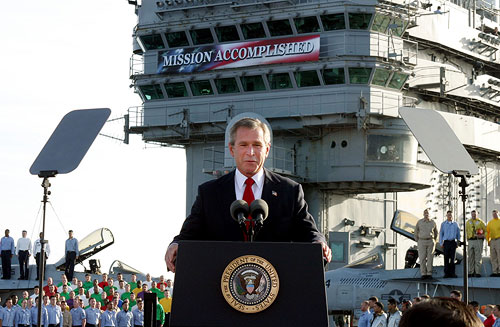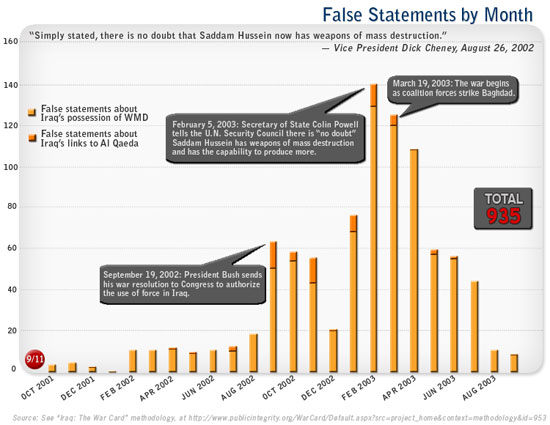iraq
Google Earth and the Middle East
Ogle Earth runs down a brief list of ways Google Earth and the availability of satellite imagery in recent years have fueled class resentment and conflict in Bahrain, Iran, Iraq, Israel, Saudi Arabia, Sudan, Syria, Tunisia, and Yemen.
Leading the list are dramatic visualizations comparing the overcrowded living conditions of the Shiite majority in Bahrain with the palaces, estates, and private islands of the ruling families. After the country’s ISPs were ordered to block access to Google Earth’s imagery in 2006, this PDF of annotated screencaps illustrating the spatial inequities circulated widely by email.
Heel the World
“This is a farewell kiss, you dog. This is from the widows, the orphans and those who were killed in Iraq.”
 On January 29, 2009, sculptor Laith al-Amiri unveiled an outsized monument of a shoe in Tikrit to commemorate journalist Muntadhir al-Zaidi who hurled his shoes at President George W. Bush. The sculpture was unveiled on the grounds of an orphanage and constructed with the help of the kids. Officials removed it the following day. The local deputy governor told CNN: “We will not allow anyone to use the government facilities and buildings for political motives.”
On January 29, 2009, sculptor Laith al-Amiri unveiled an outsized monument of a shoe in Tikrit to commemorate journalist Muntadhir al-Zaidi who hurled his shoes at President George W. Bush. The sculpture was unveiled on the grounds of an orphanage and constructed with the help of the kids. Officials removed it the following day. The local deputy governor told CNN: “We will not allow anyone to use the government facilities and buildings for political motives.”- On February 3, 2009, a protester was arrested in the UK for throwing a shoe at the Chinese premier, Wen Jiabao, at a lecture at Cambridge University. As he threw the shoe, the man shouted, “How can you listen to this unchallenged?”
- For every pair purchased, TOMS Shoes donates a pair of shoes to a child in a developing country. From May 2006 through December 2008, TOMS distributed 115,000 pairs of shoes worldwide. Shoes prevent Podoconiosis, a disease caused by absorption of silica through the feet, particularly from volcanic soil. The symptoms are swelling, ulcers, and ultimately deformity in the feet and legs. The disease is 100% preventable by wearing shoes.
- The Shoe Bank collects used shoes at schools, gyms and stores around Texas and redistributes them at shelters in Texas and to natural disaster victims abroad. The organization provides shoes for twenty thousand people every year. In September 1991, The Shoe Bank was officially recognized by President George H. W. Bush.
When Design Stopped the War
“But does it work?”
It’s one of those frequently asked questions one often hears at discussions of design and activism. That and the whole preaching to the converted thing. It refers to design specifically, but also protest generally.
It sometimes takes a long time to stop a war, but now and then the impact is immediate. Like the time in February 1998 when protestors disrupted an internationally broadcast “Town Meeting” on Iraq at Ohio State University. Students dropped a NO WAR banner in front of an CNN’s rolling cameras and made such a ruckus that the moderator had to allow them a turn at the mic. Their pointed questions about the war embarrassed the Clinton Administration, tipped public and international support, and prevented an invasion of Iraq. “Not even Ohio supports the bombing, Egyptian President Hosni Mubarak said a few days later. Why should Egypt?”
Of course, it wasn’t this one protest alone, nor solely the banner smuggled into the event. But the action, broadcast around the world via cable news, sealed the deal. Katha Pollit’s March 1998 article tells the story.
Update 3/16/2010: Here’s a transcript of the town hall meeting.
 “Protests were held in Britain, France, Germany, Greece, Ireland, Italy, the Netherlands, Spain and Turkey as the Israeli offensive entered its second week...In many cities people waved shoes — recalling the action of an Iraqi journalist who hurled footwear at U.S. President George W. Bush in Baghdad last month in a symbolic insult. British demonstrators threw dozens of shoes into the street as they passed the gated entrance to Downing Street, where Prime Minister Gordon Brown lives, and shouted angrily at a line of 40 police officers on guard there. ‘Come to get your shoes Gordon,’ one woman shouted as other marchers directed chants of ‘Shame on you’ at Brown.”
“Protests were held in Britain, France, Germany, Greece, Ireland, Italy, the Netherlands, Spain and Turkey as the Israeli offensive entered its second week...In many cities people waved shoes — recalling the action of an Iraqi journalist who hurled footwear at U.S. President George W. Bush in Baghdad last month in a symbolic insult. British demonstrators threw dozens of shoes into the street as they passed the gated entrance to Downing Street, where Prime Minister Gordon Brown lives, and shouted angrily at a line of 40 police officers on guard there. ‘Come to get your shoes Gordon,’ one woman shouted as other marchers directed chants of ‘Shame on you’ at Brown.” Screw the Flash game, since a pair was hurled at President George W. Bush the Model 271 shoe is flying off the shelf. “Baydan Ayakkabicilik San. & Tic. has received orders for 300,000 pairs of the shoes since the attack, more than four times the number his company sold each year since the model was introduced in 1999.... ‘Model 271’ is exported to markets including Iraq, Iran, Syria and Egypt. Customers in Iraq ordered 120,000 pairs this week and some Iraqis offered to set up distribution companies for the shoe, Baydan said.” More on The NY Times.
Screw the Flash game, since a pair was hurled at President George W. Bush the Model 271 shoe is flying off the shelf. “Baydan Ayakkabicilik San. & Tic. has received orders for 300,000 pairs of the shoes since the attack, more than four times the number his company sold each year since the model was introduced in 1999.... ‘Model 271’ is exported to markets including Iraq, Iran, Syria and Egypt. Customers in Iraq ordered 120,000 pairs this week and some Iraqis offered to set up distribution companies for the shoe, Baydan said.” More on The NY Times.
I Heart Iraq
While the New York Times generally doesn’t publish pictures of U.S. casualties in its own reporting, it can publish them when the photos themselves are the story (particularly on a Saturday.) The commander of the U.S. Marines in Iraq is seeking to bar photographer Zoriah Miller from all U.S. military facilities around the world for publishing photos on his web site of U.S. Marines (oh, and Iraqi civilians) killed in a June 26, 2008 suicide attack in Garma, Iraq. “Disembedding” journalists and otherwise “managing” them for publishing unfavorable coverage is nothing new. The Committee to Protect Journalists has chronicled ongoing harassment and deaths of journalists in Iraq and BAGnewsNotes has done an excellent job of unpacking the photographs that do make it out.
Looking into Miller’s own portfolio site this image caught my attention:

It has a Banksy-like irony to it: juxtaposing tools of authoritarian force with the values they are rhetorically professed to deliver — and with a faint whiff of commercialism. The vehicle above is a Iraqi Soviet-model MT-LB multi-purpose armored personnel carrier, most likely tagged, I suspect, by a U.S. soldier. But paint that slogan on an U.S. Abrams, and it makes a good stencil idea. Click below to download a PDF.
Mission Accomplished
The May 2003 image of President Bush on the deck of the aircraft carrier in front of the “Mission Accomplished” banner is, I think, one of the more memorable images from the war in Iraq. Primarily, of course, because no weapons of mass destruction were ever found (our mission, right?), the war rages on and US and Iraqi lives continue to be lost. Every day.
But there’s another story behind the image and Bush’s statement about the end of “major combat operations in Iraq.”

Below, a quote from Philip Gourevitch in conversation with Errol Morris at the 2007 New Yorker festival:
“One of the legal fictions of this period, you may think that the May 1st declaration by the President on the aircraft carrier that major combat operations had ended was merely a campaign period photo op. But in fact, it’s a redefinition of the theater of war.
During a war, you’re fighting against an enemy power and if you capture their people they’re enemy POWs and there are all kinds of rules that apply, but they’re never going to be charged with a crime. They’re simply treated as enemy combatants, enemy assets that you’re neutralizing, you remove them to the rear and as soon as combat’s over you release them. And believe it or not, May 1 of 2003 a lot of them were released. And a lot of them were kept as ‘security detainees,’ this fictitious word for prisoners. It’s a euphemism.
And the reason they were able to keep them in Abu Ghraib was because, of course, you can’t have a combat zone in a non-combat zone. And you can’t have enemy prisoners of war to whom you apply prisoner of war doctrine in a place where there is no enemy power and where there is no alternate army. So you can’t say to whom they belong and so they must be ‘insurgents.’ Insurgents against what? There isn’t an Iraqi government. So it’s a very complicated legal status, and its these loopholes that are being exploited for simply rounding people up and tossing them in there.”
And Abu Ghraib is, of course, where some of those other memorable photos were taken.
Knit-in for Peace
On March 19, the Granny Peace Brigade met in the rain in front of the military recruiting station in Times Square to mark the 5th anniversary of the U.S. invasion of Iraq, “knitting ‘stump socks’ for amputee veterans, baby blankets and other items for Iraqi families.” There were a lot of great protest actions Wednesday, but the forceful assertion of care here is striking. Grannies vs. generals; slow, manual creation vs. fast, technological destruction — this is not just non-violence, but perhaps an opposite of violence. Here’s another short video.
Every Wednesday from 4:30 to 5:30 pm Grandmothers Against the War holds a vigil at Rockefeller Center. All are welcome.




